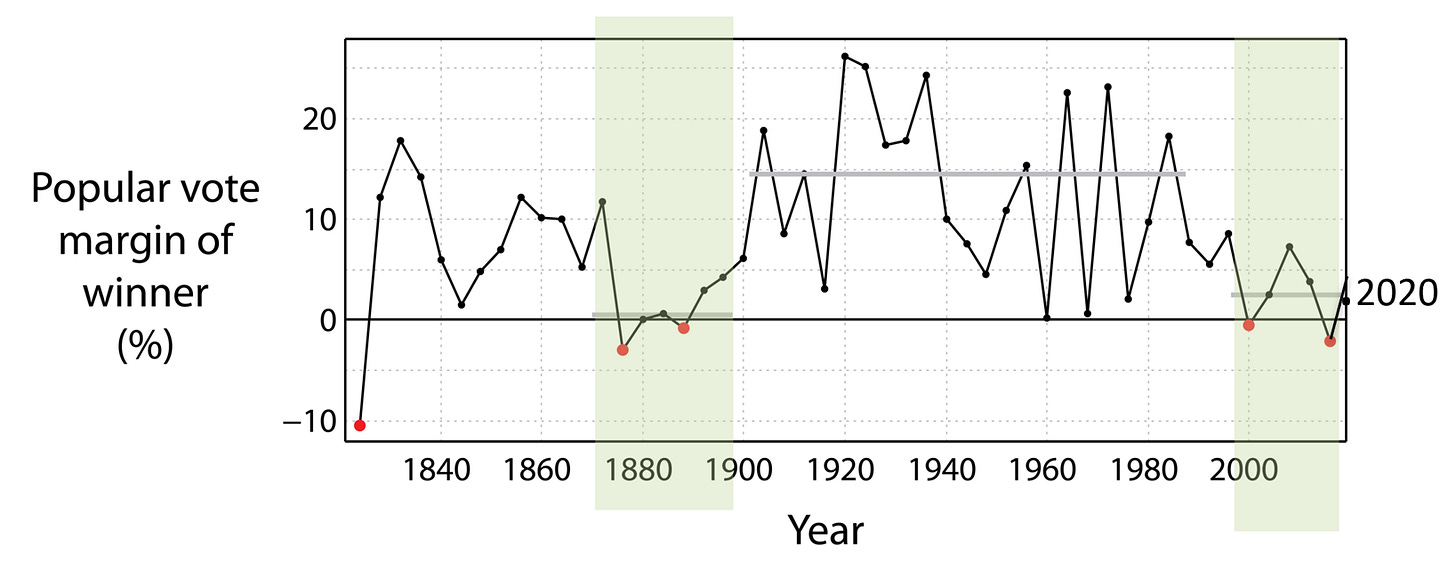This is part 1 of a series on Democracy Moneyball.
With the replacement of President Joe Biden by Vice-President Kamala Harris in the 2024 race, donors are coming out of the woodwork. Math can help maximize the potential impact of their money - and direct it to places where it can have maximum impact downticket.
Today I want to write about how the energy of 2024’s election can be used to build power in the short term - and also repair our rickety democracy in the long term.
I helped originate the field of poll aggregation in 2004 when I started the Princeton Election Consortium. From the start, the horserace was only a part of my interest. I viewed poll analysis as a means of empowering readers, by identifying how voters, volunteers, and donors can have the maximum possible leverage.
I started with the Presidency, then expanded to the Senate and House, and even explored how voters could influence 2021 redistricting. Now, with our political system more polarized than ever, it’s time to expand even further, to an optimized approach to rescuing democracy everywhere.
But how to do this with maximum efficiency? It reminds me of the Michael Lewis book Moneyball: The Art of Winning An Unfair Game, on how to build a great baseball team on a small budget. The key is analytics. Applied to politics, I will call this principle Democracy Moneyball.
Democracy Moneyball is the newest project of the Electoral Innovation Lab. EIL’s mission is to build a science of long-term democracy reform. As the 2024 campaign heats up, that mission can be used to drive change this year, right now.
As we’ve seen this week, voters are attracted by the shiny object of the Presidency. But power at every level is essential. No matter who wins the Presidential election, Republican Donald Trump or new Democratic nominee Kamala Harris, downticket races in Congress and the states play a huge role in what kind of government we have in 2025.
Let’s find a way to harness today’s new burst of enthusiasm for the Presidential race to make sure all citizens retain, or even gain, influence in years to come. Math (which we do for you, don’t worry) can help.
In this first essay, I will show how it’s possible to apply a careful eye to how power is attained through elections, then combine that with rigorous quantitative analysis. Today’s target is national and Congressional races. In later weeks I’ll get into how to strengthen democracy at the state level, through legislatures and ballot initiatives.
The insurrection of January 6, 2021 revealed the fragility of our national democracy. 2024 provides an opportunity to prevent that from happening again - both this year and in years to come.
The core concept of Democracy Moneyball is the idea that votes (and resources of time and money) are most powerful in cases where the outcome is on a knife edge. For example, in 5 of the last 6 Presidential elections from 2000 to 2020, the popular vote margin between the two major candidates has been less than 5 percentage points. That’s as many cliffhangers as there have been in the previous century (1896-1996) combined. And with supporters of both major parties more dug in than ever, under these conditions a few states hold disproportionate power.

For example, in Pennsylvania, just a few miles from here in New Jersey, each vote has a thousand-fold more influence than my puny vote. That's because Pennsylvania is on a knife edge state - and New Jersey isn't. Truly, a jerseyvote is the Weimar Deutschmark of Presidential elections.
In past years I’ve calculated this kind of difference in leverage using a detailed model of the Electoral College. This year, we’ve figured out a formula that captures three key ideas:
A single vote pushes the vote share more when a state has a small population;
The vote share is critical when the state is close to tied (Δp=average vote margin);
The stakes in each state are the number of electoral votes (EV).
It is possible to put these three ideas together in a single formula for per-vote leverage:
(For a derivation of this formula, see this explainer by visiting EIL fellow Phouswawanh Peaungvongpakdy.)
Note that this formula requires knowing what it would take for the Presidential race to be a near coin-toss. For a voter to have power locally in the Presidential election, the overall Electoral College outcome has to be in question. That’s the reason for including the “meta-margin,” a quantity that corresponds to a virtual lead. At the end of the Biden v. Trump matchup in mid-July, the meta-margin was Trump ahead by 3.8%, i.e. state-by-state Biden-Trump polling margins would have had to move, overall, by 3.8 points toward Biden to create a perfect toss-up. Voter power makes the most sense in a toss-up situation, so we need to shift the polling data to make an accurate estimate.
In the Presidential race, the states with the most voter power are currently Nevada (voter power=100.0), North Carolina (90.8), Georgia (89.1), and Pennsylvania (79.6). These states are likely to remain critical in the months to come.
Now let’s apply the same logic to downticket races. For Senate races it’s fairly easy: Democrats currently lead in five knife-edge races (Arizona, Montana, Nevada, Ohio, and Pennsylvania), which currently gets them to 49 Democratic+Independent seats. The Senate control meta-margin is a Republican lead of 0.6%. Right now, the senate races with the most voter power are Montana (voter power=100.0), Nevada (57.0), and Arizona (37.0). Tied for distant fourth are Wisconsin (11.0) and Maryland (11.0).
Therefore, if you care about the Senate, give first in Montana, Nevada, and Arizona. If you care about both the Senate and the Presidency, give first in Nevada. That’s the Democracy Moneyball principle at work.
Finally, let’s consider the U.S. House of Representatives. Here, the playing field is pretty level. Thanks to independent redistricting, ballot initiatives, and some state courts, many extremes of partisan gerrymandering in 2012 have been blunted. Based on Princeton Gerrymandering Project analytics, the overall bias in the House of Representatives is pretty close to zero. In other words, whichever party gets more votes nationally will probably gain (or retain) control. Generic Congressional polls are currently tied, so House control is also a toss-up. Truly everything is up for grabs in 2024.
Note that the leverage principle here is symmetric with respect to political party. If voter leverage is high for Democrats in a state, it’s also high for Republicans. For that reason, I’ve set up two places for you to donate: ActBlue for Democrats, and WinRed for Republicans. (The WinRed site omits election deniers who would undermine the counting of votes, past or future.)
If you like all of this...something even better is on the horizon. The Electoral Innovation Lab is developing an app that makes all of the analytics above easily available to you. The app, tentatively called Democracy Moneyball, will list key states for the Presidency, the U.S. Senate, and the U.S. House.
But it will also do more. EIL’s Democracy Moneyball will include also include state power, where the future of democracy lies. As the U.S. Supreme Court becomes increasingly hostile to voting rights, the best route to preserving the power of voters is through the states. Democracy Moneyball will therefore include state legislatures and ballot initiatives, places where voters can have outsized influence in their own communities, and preserve and improve democracy for years to come. In short, the app makes it possible for you to maximize your power over what happens in 2024 - and for years to come.
Stay tuned for more.
Support the Electoral Innovation Lab here. Democracy Moneyball (federal) candidates can be found at these curated ActBlue and WinRed sites.






I would love to be able to donate through Apple because I want to give an anonymized email (so that Actblue doesn't spam me, like they tend to do.) How come is that not enabled?
Thanks for again bringing the math to bear!